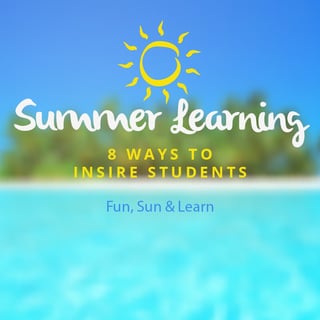 Let me begin by saying that summer should be summer – our students should have time to play and relax! Even though my wife and I are both educators, we believe that summer downtime is essential for all of our kids, regardless of their age. In our house, we “summer” hard. We stay up late, sleep in, often have no real plan for the day, and enjoy the freedom of summer.
Let me begin by saying that summer should be summer – our students should have time to play and relax! Even though my wife and I are both educators, we believe that summer downtime is essential for all of our kids, regardless of their age. In our house, we “summer” hard. We stay up late, sleep in, often have no real plan for the day, and enjoy the freedom of summer.
That being said, once the summer rolls on for a little while, we usually find that our own kids start needing some engagement and some mental stimulation. We’ve found a number of ways to help maintain active brains over the long summer break. Here are eight ideas for your students and their parents.
- Send students home with some learning. Many teachers send home the unused workbook pages or handwriting sheets for the summer. This isn’t a bad thing, but my own kids usually use these types of materials to “play school” and not really to learn. Instead, try sending them home with the unused pages of their journal and a list of 50 journal topics for the summer. You might also keep your classroom blog open for the summer, so they can continue to write there. And lots of kids would enjoy having a packet of at-home science activities that they can do with supervision from their parents.
- Prepare them for the fall. If you already know which students you will have next year, you might give them a few things to prep for over the summer. These could be books to read, math concepts to explore, or history topics to research. You don’t want to go overboard on any of these. But if parents want their kids to be reading anyway, why not start them on content that will help build knowledge for the upcoming year?
- Have them do some vacation research. We are the nerdy family that often skips the amusement park to go to the historical landmark. For example, our second grader is insisting that we stop at the San Jacinto Monument when we travel to Galveston this summer, I had never heard about it before, but he knew about it from some nonfiction reading he did this year in class. If your students have travel plans for the summer, have them research the area of their destination a little bit. Parents may not want to stop at every oddity along the way – like the World’s Largest Ball of Twine – but doing the research is a great way to engage kids in geography and history, while developing real-world connections.
- Suggest a little online collaborative writing. During the last few days of school, have students plan a collaborative writing project. They can email or message one another over the summer to complete it. Make the project completely for fun and not at all “for a grade.” That way, students can enjoy writing whatever they want, while working with their friends.
- Have them try some online programs. Whether your students are struggling, need a challenge, or are right on grade level, they can all benefit from working on math standards and reading. There are many online programs that schools have access to that allow students to work over the summer. Send home the online access codes (and post them on the school website for later) to keep the students moving forward.
- Encourage some screen time. Learning through media might seem a little “anti-summer,” but it’s an excellent way to keep students thinking. Instead of mindless Nickelodeon cartoons, introduce them to some classic learning examples, such as Wizard or The Secret City. Kids may find the dated nature of them funny, but they are simple and easy for students to work along with while they learn.
- Help students earn summer school credits. For some secondary students, summer is a time to get back on track to graduate. There are many summer school opportunities, and some high schools now have virtual schools that can provide credits. High schools differ on options and requirements. If your local high school doesn’t have any options available, an alternative online option could be FuelEd.
- Suggest external opportunities. Although summer camps can be costly, many of them offer a deeper and more engaging learning opportunity. Camp Invention is a great program that has sites all across the country. Many school districts are also developing STEAM camps of their own, which also provide engaging, problem-based learning. (If there isn’t one of these in your area, maybe you should be the person to start it!) At the very least, your local public library will have reading programs and maker space opportunities over the summer.
No doubt you can come up with many more ideas for summer learning. The key objective is to keep students learning in an enjoyable way, so any and all methods should be considered. Parents will thank you for doing the extra work to keep their kids engaged and continuing to learn.
Educators, you are not left out of the summer fun – we also have a list of ways that teachers can keep enrichment going all summer long. Check it out here.>>
Have a great summer, and happy learning!



